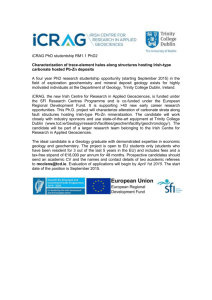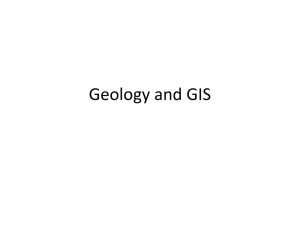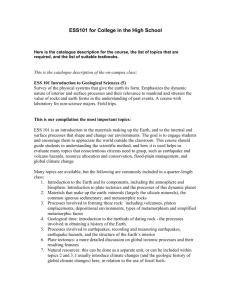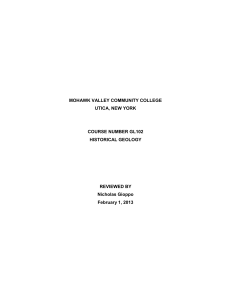AY 2014-2015
advertisement
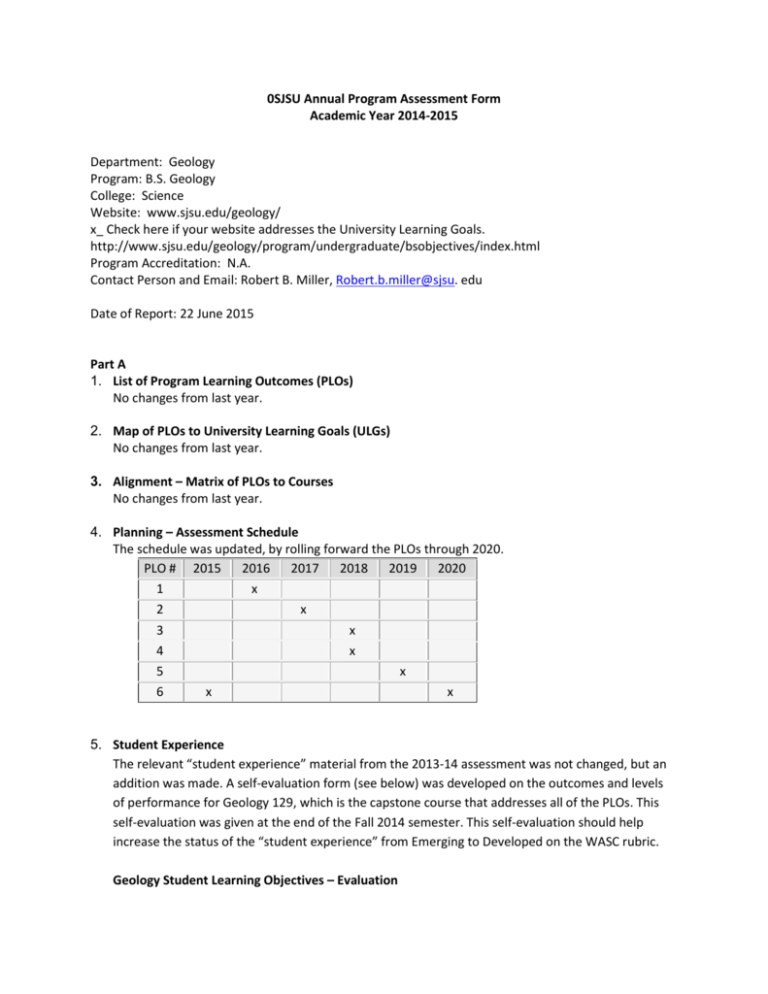
0SJSU Annual Program Assessment Form Academic Year 2014-2015 Department: Geology Program: B.S. Geology College: Science Website: www.sjsu.edu/geology/ x_ Check here if your website addresses the University Learning Goals. http://www.sjsu.edu/geology/program/undergraduate/bsobjectives/index.html Program Accreditation: N.A. Contact Person and Email: Robert B. Miller, Robert.b.miller@sjsu. edu Date of Report: 22 June 2015 Part A 1. List of Program Learning Outcomes (PLOs) No changes from last year. 2. Map of PLOs to University Learning Goals (ULGs) No changes from last year. 3. Alignment – Matrix of PLOs to Courses No changes from last year. 4. Planning – Assessment Schedule The schedule was updated, by rolling forward the PLOs through 2020. PLO # 2015 2016 2017 2018 2019 2020 1 x 2 x 3 x 4 x 5 x 6 x x 5. Student Experience The relevant “student experience” material from the 2013-14 assessment was not changed, but an addition was made. A self-evaluation form (see below) was developed on the outcomes and levels of performance for Geology 129, which is the capstone course that addresses all of the PLOs. This self-evaluation was given at the end of the Fall 2014 semester. This self-evaluation should help increase the status of the “student experience” from Emerging to Developed on the WASC rubric. Geology Student Learning Objectives – Evaluation Geology 129 (field camp/capstone experience) students: The Geology Department wants your feedback on how well you judge that you have achieved one of the Department Program Learning Objectives (all are listed on the class Greensheet). Please write your comments anonymously (no signature) on this page and give the survey to Leslie Blum in the Department Office. Program Learning Objective 6: “Represent and interpret earth history through deep time.” Part B Item 6. Graduation Rates by Entering Cohorts: Geology First-Time Freshmen Undergraduate Transfer New Credential Fall 2008 Cohort: 6Year Graduation Rate Fall 2011 Cohort: 3Year Graduation Rate Fall 2011 Cohort: Fall 2011 Cohort: 3-Year 3-Year Graduation Graduation Rate Rate First-Time Graduate University Average Grad Rate - All Students Who Entered the University College Average Grad Rate - All Students Who Entered This College Program Grad Rate Program Cohort Size University Average Grad Rate - All Students Who Entered the University College Average Grad Rate - All Students Who Entered This College Program Grad Rate Program Cohort Size University Average Grad Rate - All Students Who Entered the University College Average Grad Rate - All Students Who Entered This College Program Grad Rate Program Cohort Size University Average Grad Rate - All Students Who Entered the University College Average Grad Rate - All Students Who Entered This College Program Grad Rate Program Cohort Size Total 1 0.0% 45.0% 49.7% 2 50.0% 47.4% 55.3% 0 /0 /0 8.3% 10 0.0% 27.6% 60.8% URM 1 0.0% 26.5% 40.7% 0 /0 47.6% 55.2% 0 /0 /0 12.2 1 % 0.0% 10.0% 65.2% NonURM 0 /0 49.1% 53.3% 2 50.0% 39.2% 54.9% 0 /0 /0 8.0% 7 0.0% 19.8% 54.2% 52.8% 52.9% 0 /0 /0 /0 4.9% 2 0.0% 50.0% 69.4% All others 0 /0 64.9% 56.9% 0 Very few freshmen enter SJSU as Geology majors, in large part reflecting that few college-bound students are taught Earth Science in high school. Thus, there are so few students that the graduation rates lack statistical validity. Fortunately, this should change with the recent adoption by California of Next Generation Standards for science education which place much new emphasis on Earth Sciences. Our number of UG transfers is higher than that of first-time freshmen, though getting a statistical graduation rate is still dubious. That said, we wish to improve the 3-year graduation rates. The low rates probably in large part reflect that many of the transfers have not taken the necessary classes in calculus, chemistry, and physics before they arrive here. The Department hosted the local community college Earth Science instructors at a luncheon in May of 2014 and discussed transfer issues. We plan future meetings and hope that there will be better streamlining of the transfer process. Item 7. Headcount of Program Majors by Degree: Geology Fall 2014 New Students Continuing Students 2 2 8 8 Total 44 30 14 Trnst-Ugrd 7 7 Retn.Tranf 10 2 8 Continuing New Transf FT Admit Total BS MS 71 49 22 The number of BS majors has increased significantly (by 49%) in the last few years, from a low in 201213 to 2014-15 (see supplementary table compiled by the Department after Item 9), and the numbers in junior and senior-level classes are larger than at any time since 1986. Item 8. Student-Faculty Ratio (SFR) and Average Headcount per Section: GEOL - Geology Fall 2014 Fall 2014 35.1 31.0 23.2 22.5 25.5 7.1 9.6 20.8 Lower Division Upper Division Graduate Division University Headcount per Section 27.3 College Headcount per Section Subject Headcount per Section University SFR College SFR Subject SFR Lower Division Upper Division Graduate Division 39.3 48.7 35.6 26.8 24.8 28.0 4.8 5.1 15.8 The SFR and average headcount have also increased dramatically. As summarized in the supplementary table after item 9, the overall SFR increased 42% from a low of 16.5 in 2010-11 to 23.4 in F 2014 (Spring 15 not included). The headcount (average section size), as calculated by IEA and summarized in the supplementary table, increased 28% from 18.1 in 2010-11 to 23.2 in 2014-15. If supervisory sections are not included, the average section size increased 45% from 2010-11 to 2014-15. We also note that the headcount for graduate students is negatively affected relative to many departments by the way that credit is assigned for supervision courses. That is, individual sections are assigned to each faculty member to insure proper credit, and there are a significant number of graduate students for the size of Department. Formal graduate classes generally have >10 students. Item 9. Percentage of Full-Time Equivalent Faculty (FTEF): Geology Fall 2014 University FTEF % College FTEF % Department FTEF % Department FTEF # Tenured/Tenure3.7 track Not tenure-track 4.6 8.3 Total 45% 53.7% 42.8% 55% 100% 46.3% 57.2% 100.0% 100.0% GEOLOGY FTES AND CLASS SIZE (Compiled by Department) FTES 2014-15 264.5 SFR 23. 4 *Sect. Size Majors 23.2 (34.1) 49 2013-14 234.1 21. 2 22.6 39 2012-13 226.4 17. 8 22.9 33 2011-12 221.6 17 19.5 36 2010-11 200.8 16. 5 18.1 (23.4) 2009-10 179.8 18. 3 21.1 *Includes supervision sections. If these sections are not counted, section size ranges from 23.4 in 2010-11 to 34.1 in 2014-15 Part C 1. Closing the Loop/Recommended Actions The Department has devoted significant time in faculty meetings in the spring semester during the last three academic years to discuss assessment. We go over the assessment reports for the specific PLO(s) evaluated (#6 this year) and then discuss the PLOs in general. We did not change the curriculum or pedagogy in Geology 129 (PLO), our capstone course, since the last time this PLO was assessed. We have, however, modified the sequencing of the class for spring 2016 and summer (formal session) 2016. Geology 129 will be taught as a 2+(2 or 4) unit sequence with all students taking an introductory 2-unit section (Geol 129A) in the spring prior to the summer field course. This will be followed by the summer course where students can earn either 2 or 4 units of additional credit toward their degree, depending on whether they complete 1 or 2 geologic mapping projects with accompanying geologic reports. For the last 2 years, students had the option of skipping the introductory 2-unit section, which did not seem logical, as it resulted in students having an uneven field experience when they started the class in the summer. Four units of Geology 129 are required for the B.S. degree and 2 additional units may be counted as Geology elective units. Follow-Up From Meeting with Julie Sliva and Elaine Collins the COS coordinators for Assessment The precision of the wording of PLOs #5 and particularly #6 were discussed. The chair intends to revise the wording, but wants to obtain the formal approval of the entire Department faculty. Unfortunately, this has yet to be done. 2. Assessment Data and Analysis The following PLO was assessed for this report. PLO 6. Understand how geologists measure deep time and reconstruct earth history. This PLO is a fundamental aspect of geology and the Earth Sciences as a whole, and is assessed to varying degrees by most of the core and elective classes in the major. Most directly, Geol 7 and 28 introduce the PLO, Geol 124 reinforces it, and 129A-129B/C (field camp) is the class where it is formally assessed. A major theme of Geology 7 (Earth, Time, and Life) is the study of the methods and approaches that geologists have used to measure deep time and reconstruct Earth's history. Two Geology 7 labs relate directly to this program learning objective: In Lab 3 ("Sedimentary Rocks and Their Depositional Environments"), students are presented with a series of sedimentary rocks said to have been collected from a stratigraphic section. The students identify the rocks and then--based on paleoenvironmental interpretations of the rock types (e.g., black shales represent deep water, while coals represent terrestrial swamps)--reconstruct how the region where the rocks accumulated changed over time. In Lab 4 ("Geological Time"), students apply basic principles of geology (such as superposition and crosscutting relationships) to determine the relative ordering of events that are depicted in provided geological cross sections. They also calculate the ages of hypothetical mineral samples based on provided half-life decay constants and amounts of radioactive isotopes remaining. Assessment of the latter in Spring 2015 showed that 75 of 120 students (63%) achieved perfect scores on the corresponding lab problem (note that assessment metrics for 2 sections were not recorded). Assignments in Geology 124 (Sedimentology and Stratigraphy) include two 2-week laboratory exercises, one based on outcrop data from Nevada and one based on seismic reflection data from Morocco, in which students analyze the data and use their analysis to describe the geologic histories of each of the two areas they studied. In Geology 129 (Field Geology), all students must prepare a comprehensive geologic report, which is the primary assessment tool used in the course. The report includes: rock descriptions, description of the stratigraphy (sequence of strata through time), stratigraphic sections, interpretation of the geological history, geologic maps, and geologic cross-sections of the map area. Students must first identify and classify all of the rock units that are in their map area. The disposition of the rock units (i.e. their relationship to each other) is accomplished by the mapping of the rock units in the field and identifying the types of contacts between them (e.g., faulted, depositional). Several parts of the report are particularly relevant to PLO #6. 1). Students measure, depict graphically, describe, and interpret a stratigraphic section from one of the formations in their map areas. The interpretations force them to evaluate changes in sedimentary deposition with time. 2) As part of the mapping, students identify fossils, which are used to interpret the relative ages of the rocks (e.g., Cambrian - ~ 530 million years ago vs. Pennsylvania – 300 million years ago), and enable students to further recognize how depositional setting has changed with time. 3) In the section on geologic history in the major report, a student synthesizes all of the data gathered over 3 weeks to interpret the geologic history of the region, emphasizing how the region has changed with time. The report is assessed using a standardized rubric that assesses how well the students perform on each individual part of the report as well as the writing. A separate rubric is used for evaluating the geologic map, cross sections, and stratigraphic sections. In fall 2014 (instruction took place in summer 2014) there were 21 students who took Geology 129. Of these, 4 scored excellent in meeting the PLO, 10 scored well, 5 others were deemed satisfactory, and 2 did not meet the expectation for this PLO. Both of the latter students have not performed particularly well at SJSU (<2.2 GPA). Proposed changes and goals As stated above, the Department did not change the curriculum or pedagogy in Geology 129 since the last time this PLO was assessed. In the future, Geology 129 will be taught as a 2+(2 or 4) unit sequence with all students taking an introductory 2-unit section (Geol 129A) in the spring prior to the summer field course. This will be followed by the summer course where students can earn either 2 or 4 units of additional credit toward their degree, depending on whether they complete 1 or 2 geologic mapping projects with accompanying geologic reports. Four units of Geology 129 are required for the B.S. degree and 2 additional units may be counted as Geology elective units. The feedback from the students (described in “student experience”) on meeting the PLO was uniformly positive. That said, the number of students returning the questionnaire was <50%. We will give this form out while in the field to spur more of a response.



